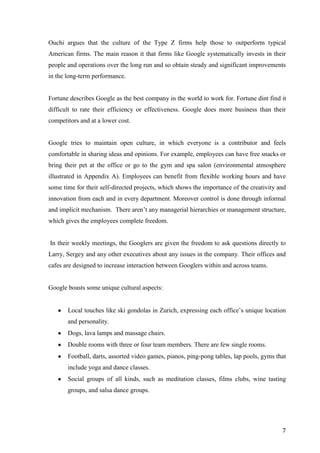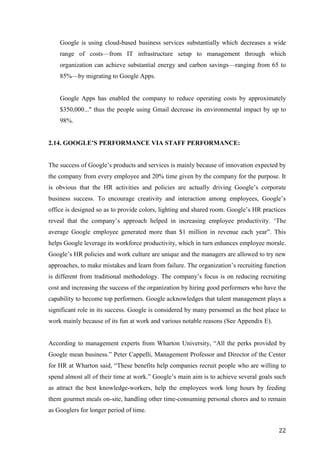Google has a unique organizational culture and HR strategies that have helped it become one of the top companies to work for. They hire only the best talent and provide an empowering work environment with perks like flexible hours, free food and activities. Their flat structure promotes collaboration and transparency. Performance is evaluated qualitatively rather than just metrics. Compensation is competitive with bonuses for team and individual achievements. Their people-first approach has allowed Google to attract top talent and drive innovation.

























![4. REFERENCES:
A Look Inside the Google Talent Machine [online] Available at
http://humanresourcesmagazine.com.au/articles/B1/0C0429B1.asp?Type=60&category=1223
Baker Loren, Google Receives 1,000,000 Job Applications a Year [online] Available at
http://www.searchenginejournal.com/google-receives-1000000-job-applications-a-year/4308/
Barney J.B. (2002), Gaining And Sustaining Competitive Advantage, Prentice Hall, 2 nd
Edition.
Benefits, Google Inc [online] Available at
http://www.google.com/support/jobs/bin/static.py?page=benefits.html
Deal, T. & Kennedy, A. (1982). Corporate cultures. Reading, MA: Addison-Wesley.
Fletcher Sarah, ―Google: Recruiting and Developing Top Talent‖ [online] Available at
http://www.trainingzone.co.uk/cgi-bin?id=164515
Getting into Google [online] Available at
http://www.google.com/support/jobs/bin/static.py?page=gettinggoogle.html
Google, Inc. Company history [online] Available at
htttp://www.fundinguniverse.com/company-histories/Google-Inc-Company-History.html
Iyer Bala and Davenport Thomas H., Reverse Engineering Google‘s Innovation Machine,
Harvard Business Review, April 2008
Lashinsky Adam, ―Life Inside Google‖ [online] Available at
http://money.cnn.com/galleries/2007/fortune/0701/gallery.Google_life/8.html
Corporate Social Responsibility [online] Available at
http://www.google.cn/intl/en/about/company/responsibility/
26](https://image.slidesharecdn.com/googleproject-130124084424-phpapp02/85/Google-project-26-320.jpg)
![Strategic Analysis of Google [online] Available at
http://www.slideshare.net/josh633/strategic-analysis-google
Sullivan John, ―Google Continues to Innovate In Recruiting and Candidate Assessment‖
[online] Available at
http://www.rer.net/articles/db/95872408130C40EC8AD8B3FF0975D145.asp
Tom Burns and G.M. Stalker (1961) Organic Systems [online] Available at
http://valuebasedmanagement.net/methods_burns_mechanistic_organic_systems.html
―Top 10 Reasons to Work at Google‖ [online]
http://www.google.com/support/jobs/bin/static.py?page=about.html&about=top10
―100 Best Companies to Work For‖ [online] Available at
http://money.cnn.com/magazines/fortune/bestcompanies/2008/jobgrowth/
‗The Google Approach to Employee Selection‖ [online] Available at
http://sites.thomsonreuters.com.au/recruitment-extra/2010/09/14/the-google-approach-to-
employee-selection/
―Performance Reviews At Google‖ [online] Available at
http://www.quora.com/How-are-performance-reviews-done-at-Google-What-are-they-used-for
―Workforce Education Program‖ [online] Available at
http://online.wsj.com/article/SB10001424052702303410404577466852658514144.html
HR Strategic Planning Google‖ [online] Available at
http://www.scribd.com/doc/13286610/Strategic-HR-Planning-at-Google-Inc
27](https://image.slidesharecdn.com/googleproject-130124084424-phpapp02/85/Google-project-27-320.jpg)




